AMD Demonstrates Ryzen Performance At New Horizon Event, 95W TDP Confirmed
AMD held a live-streamed New Horizon event yesterday at the official public unveiling of the new Ryzen processors. The demonstrations included several CPU-intensive workloads, such as Blender and Handbrake, and 3D rendering tasks with the ZBrush and KeyShot applications. No enthusiast demonstration would be complete without gaming, so AMD also included Star Wars: Battlefront (Rogue One DLC), Dota 2, and Battlefield 1 demonstrations.
AMD based Ryzen, the CPU formerly known as Summit Ridge, on the Zen core architecture, and it is destined for the desktop PC first. AMD provided us with details of the new chip and some of its features during an invite-only event last week, and we also gleaned several architectural details from a briefing at HotChips earlier this year.
The rise of Zen has brought about a palpable level of both excitement and anxiety among the enthusiast crowd. We are hopeful, but also tend to temper the excitement with a stiff glass of Bulldozer, which also debuted among much anticipation but ended in disappointment. Ryzen will come to market bristling with eight cores and 16 threads and a 3.4GHz (possibly higher) base clock, though the boost clocks remain undefined. The 8-core chip features 4MB of L2 and 16MB of L3 cache and will snap into the AM4 socket. Other particulars, such as memory and PCIe provisioning, remain unconfirmed, though we do know AM4 will support DDR4 memory, PCIe 3.0, USB 3.1 Gen2, NVMe, and SATA Express.
Of course, the only way to put the speculation to rest is for reviewers and users to test the processors and pass judgment, but in the interim, AMD provided us with several encouraging demos, although some lacked hard data. We already have an in-depth breakdown of the latest revelations about the new features of the Ryzen CPUs, but let's take a closer look at AMD's benchmarks.
Blender 3D Rendering
AMD already treated us to a Blender benchmark rendering the original Zen logo during its initial reveal, but the company conducted the demonstration with an underclocked Intel Core i7-6900K to normalize the test and highlight Ryzen's IPC performance.
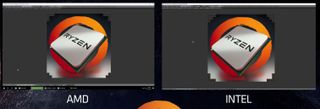
The new test pitted the Ryzen 8-core against the same 8-core Intel Core i7-6900K, but this time AMD chose to handicap its own processor with a base 3.4GHz clock and no boost while the i7-6900K utilized its stock configuration with a 3.2GHz base clock and 3.7GHz boost. The CPUs rendered the new Ryzen logo, and the tests finished within a second of each other.
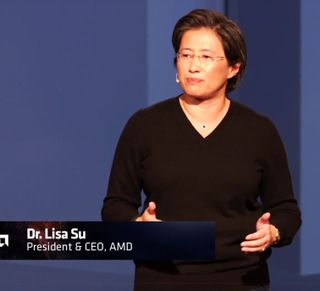
The Intel system appeared to win by a hair, but AMD did not provide the actual time measurements. AMD's Lisa Su pointed out that the Ryzen processor featured a mere 95W TDP compared to the i7-6900K's 140W TDP, which is impressive considering the close contest without Ryzen's boost clocks. AMD also is still tuning Ryzen, so there is room for more improvement. The results suggest the Ryzen CPU can provide comparable performance within a lower power and thermal envelope during heavy multi-threaded CPU-intensive workloads. Su also mentioned the i7-6900K's $1,100 price tag but did not provide a comparative price for Ryzen.
Stay on the Cutting Edge
Join the experts who read Tom's Hardware for the inside track on enthusiast PC tech news — and have for over 25 years. We'll send breaking news and in-depth reviews of CPUs, GPUs, AI, maker hardware and more straight to your inbox.
HandBrake Transcoding
AMD demonstrated the same Ryzen and Intel i7-6900K systems used for the Blender test competing against one another during a HandBrake video transcoding job.

Ryzen beat the Intel comparable by five seconds during the heavy multi-threaded workload. There are many facets that still remain veiled, such as single-threaded performance, but the head-to-head bodes well for Ryzen's heavy workload performance.
AMD also noted that you could download the same test that it ran for the demo at amd.com/ryzen, which will allow you to compare your system to the Ryzen demonstration.
Battlefield 1
The Battlefield 1 demo consisted of two Titan X-equipped systems, one with Ryzen and the other with the Intel i7-6900K, playing the game with a 4K resolution at maximum settings. It is notable that AMD chose to use an Nvidia Titan X instead of one of its own GPUs, but AMD designed the test platforms to highlight CPU limitations by removing the GPU bottleneck.

AMD claimed its new prefetch and branch prediction engines, upon which they've bestowed the Neural Net Prediction and Smart Prefetch monikers, provide a smooth gaming experience that hovered in the 60-70FPS range for the Ryzen system. This is purportedly equal (or close) to the Intel-driven platform. AMD noted that there were visible FPS counters during the demo, but I was unable to make them out during the livestream. The counters were likely viewable for members of the audience.
Ryzen's Neural Net Prediction and Smart Prefetch features sound remarkably similar to existing CPU technologies, such as branch predictors and instruction prefetch, but we will not know more about the differentiating aspects until AMD drills further down into the architectural improvements. It is notable that Intel processors feature similar technology.
Dota 2 And Twitch
AMD had PPD from Evil Geniuses on hand to demonstrate simultaneously playing Dota 2 and livestreaming his gaming session to Twitch in 1080p. Again, AMD didn't provide any hard performance metrics, but it also had a similar configuration with the i7-6900K providing nearly identical performance during the same tasks.
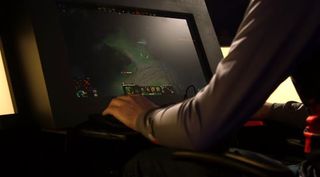
AMD also had another Intel platform configured with a Core i7-6700k overclocked to 4.5GHz, but the company indicated that it dropped frames as it struggled with the encoding workload.
Interestingly, the demonstration meshes nicely with Intel's mega-tasking marketing, which pushes the importance of high performance during simultaneous heavily multi-threaded applications, such as the aforementioned gaming/streaming workload. Intel positions its top of the line Broadwell-E processors as mega-tasking monsters, but they do come bearing prohibitive price tags that range up to $1,100 (as AMD continuously noted during the webcast). Comparing Ryzen to the much lower-cost i7-6700K (~$340) may send a message that the company plans to be cost-competitive with Intel's less expensive SKUs.
The Miscellaneous Demonstrations - HTC Vive VR, ZBrush, and KeyShot 3D Rendering
AMD also held several demonstrations that were somewhat subjective and did not provide any hard performance data, which we've lumped together into this section.
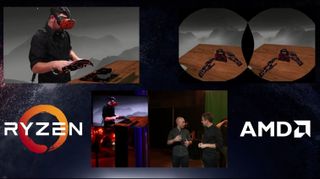
Virtual Reality is the hottest new tech, and its implications for the desktop are profound. AMD demonstrated VR with an HTC Vive in a mixed reality environment as the user built a Ryzen desktop system in VR.

AMD's ZBrush demonstration employed the 3D sculpting and painting program to highlight performance with a CPU-intensive rendering workload. The ZBrush demonstration rendered 3.5 million polygons, and a game dev noted that another developer was using Ryzen with 25 million polygons at the event. The developer also demonstrated KeyShot, a CPU-based 3D rendering program, rendering a Ryzen chip with 53 million polygons. The renderings appeared to be smooth and flowing, but the demonstration did not provide performance metrics.
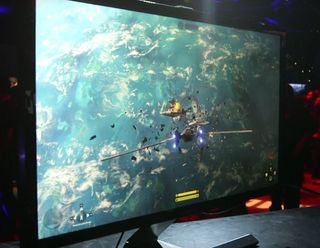
Finally, AMD demonstrated the Ryzen CPU with a single Vega GPU playing the forthcoming Star Wars: Battlefront Rogue One DLC with a 4K resolution. The demo appeared to play lag and stutter-free, and Lisa Su noted that the game was rendering above 60FPS, although there was no real-time FPS output.
Ryzen On Schedule, More Info To Come
Lisa Su stated that Ryzen is still on schedule for its Q1 2017 release date, which is encouraging, but there is apparently still more optimization work in the months ahead. If things go as planned, performance will increase, so when Ryzen hits the market it may bring performance that is even more impressive.
The slow trickle of information is promising, but each new revelation brings about more questions, such as single-threaded performance and PCIe and memory allocations. Ryzen's overclockability and pricing also loom as pressing questions. We can reasonably assume that AMD will be very cost competitive, but overclock capabilities, and how the Precision Boost feature works into the equation, are important factors for enthusiasts. AMD is clearly angling for the enthusiast market, which could lead to some tentative optimism on the overclocking front. We expect more information to emerge during CES in the coming month.

Paul Alcorn is the Managing Editor: News and Emerging Tech for Tom's Hardware US. He also writes news and reviews on CPUs, storage, and enterprise hardware.
-
hst101rox I would be interested in a high-end mobile AMD CPU .. hopefully a 45w part not just up to 35 watts TDP so it can be clocked decently high. Otherwise, a high-end 45w Kaby lake for me in a MSI GS73VR please.Reply
For many generations, AMD has stuck with 35w and less for mobile chips, disappointing. -
metathias This bodes well for AMD, The core to core comparison is obvious. AMD has a good CPU on their hands. Question is. How much?Reply -
fry178 not sure why every website mentions that the i7 was running at 3.2-3.7.Reply
unless the bios settings are on auto and its LC, running encoding/rendering on all 8 cores will prevent boost clocks.
so to me, this is actually showing that AMD only beats the 6900K, when its (slightly) clocked higher (3.4 vs 3.2).
even if its only a little.
if the IPC is sooo good, why not run both cpus with fixed 3.2GHz on all cores?
right, cause then we would see a difference.
i dont expect a sub 500$ cpu to beat the 6900K (and it doesnt need to anyway), but i would like AMD to be a little bit more conservative on perf,
rather than showing stuff that wont hold up once its on the market..
@metathias
would it matter? since ipc is close to intel and the 8/16 is sub 800$ its still a win.
i expect it to be around 500, maybe 350 for the lower clocked ones.
and even if they are that expensive, i can still save by goin 6 core.
a 5820K will still cost 3-400, and i doubt a 6C/12T ryzen will cost that much. -
JamesSneed Reply19004817 said:not sure why every website mentions that the i7 was running 3.2-3.7.
unless the bios settings are on auto and its LC, running encoding/rendering on all cores will prevent boost clocks (which is when not all cores are used).
so to me, this is actually showing that ryzen 8/16 only beats the 6900K when its clocked higher (3.4 vs 3.2), even if only is a little.
if IPC is sooo good, why not run both cpus with 3.2GHz on all cores (fixed)?
They did that test already to show IPC and people complained. Also, the stock 6900K runs at 3.2Ghz and turbos to 3.7Ghz by default. Essentially AMD didn't touch any settings on the 6900K. So it is by far the most valid test albeit AMD did not have the "turbo" on there CPU enabled. The conclusion if you were to make one is that the stock AMD chip vs the stock Intel chip are fairly on par with each other. I don't think I would read anything else into it until independent tests are done.
-
TJ Hooker Reply19004817 said:not sure why every website mentions that the i7 was running 3.2-3.7.
unless the bios settings are on auto and its LC, running encoding/rendering on all cores will prevent boost clocks (which is when not all cores are used).
http://www.tomshardware.com/reviews/intel-core-i7-broadwell-e-6950x-6900k-6850k-6800k,4587-9.htmlTomshardware said:Despite a 3.2GHz base clock rate, Turbo Boost pushes the CPU to 3.7GHz in lightly threaded workloads. Our sample managed to maintain this frequency across all cores during the stress test. One core even reportedly hit 4GHz.
Edit: Emphasis added. -
fry178 @JamesSneed/TJ HookerReply
exactly: under LIGHT load.
so it might boost during a game bench etc, but not when doing something like rendering/encoding etc..
which to me is a little bit better to compare the performance between "similar" cpus, since there are less fluctuations on stuff like clocks.
at least for previous i7, you would normally see a drop around 200-500MHz the more cores are running, so 3.2 when all cores under full load. but ppl tend to remember last given info (3.7), which then might make them believe the amd beats it while running at only 3.4.
and again, no matter "who" tested it, any higher clocks than 3.2 (on 6900K, when all cores at full load), means the bios is not set to reg/normal but rather on auto (for vrm/cpu clock/volt/power/temp limits etc).
its actually pretty common for the big board makers to apply some oc with auto settings, so they get better bench results in reviews.
my 3770k ran @4.3 on all cores with LC, all settings auto.
once i switched to norm/reg/man with "stock" intel limits set, it would run all cores at max 3.5, up to 3.9ghz for a single core. -
TJ Hooker Reply19005145 said:@TJ Hooker
exactly: under LIGHT load.
which isnt the case when rendering, were all cores run at 100%.
at least for previous i7, you would normally see a drop around 200-500MHz the more cores are running, so 3.2 when all cores under full load (not the 3.7 when boosting)
3.7 GHz across all cores in Aida64’s integrated stress test. Is that a "light load"?Tomshardware said:Our sample managed to maintain this frequency across all cores during the stress test. -
TallestJon96 Very interesting stuff, (and a very mediocre presentation). IPC seems almost identical to broadwell. That old figure AMD threw out of 2% faster than broadwell seems pretty damn accurate. Their messaging has been consistent of matching intel, and I believe them. The surprising thing is the efficiency claims. They might beat Intel at their own game here.Reply
This eight core beast is of little interest to me, as I am primarily a gamer and I already have an overkill i7-6700, but a 4 core 8 thread or 8 core 8 thread (will that exist ?) at say $250-$350 could be very compelling. Again, as a gamer, I am not looking to upgrade for a little while, but I kinda want to see AMD kick intels <language edit> in the high end.
It has been rumored that intel is finally going to increase core count in the 2018/2019 release, one step after coffee lake, two steps after kaby lake. I sincerely hope this happens and AMD is able to compete.
I view this launch as the start of Intel's Core series. I expect there to be incremental improvements to this basic cpu architecture for the next couple years. Intel has essentially been releasing the exact same CPU with a few tweaks every year, and they seem to be running out of room for more performance, while AMD can probably optimize another 20% IPC out of the arcitecture. If they can get the coming Zen iterations to substantially beat intel in IPC, I would love to buy one of their chips. For me it is kinda a side step not an upgrade right now.
Bring on the prices and reviews. -
rhysiam Reply
But as @JamesSneed said above, they locked both processors at the same clocks and ran a blender test a while back to show similar IPC.19005145 said:@JamesSneed/TJ Hooker
exactly: under LIGHT load.
which isnt the case when rendering, were all cores run at 100%.
at least for previous i7, you would normally see a drop around 200-500MHz the more cores are running, so 3.2 when all cores under full load (not the 3.7 when boosting)
ppl tend to remember last given info (3.7), which then might make them believe the amd beats it running at only 3.4.
and again, no matter "who" tested it, any higher clocks than 3.2 when all cores at full load, means the bios is not set to reg/normal but rather on auto (for vrm/cpu clock/volt/power/temp limits etc).
its actually pretty common for the big board makers to apply some oc with auto settings, so they get better bench results in reviews.
my 3770k ran @4.3 on all cores with LC, all settings auto.
once i switched to norm/reg/man with "stock" intel limits set, it would run all cores at max 3.5, up to 3.9ghz for a single core.
Anyway, in the end of the day, IPC is actually less important than actual performance and power consumption. If FX processors could have run at 7Ghz with acceptable power draw, no one would have cared about the low IPC because the performance would have been competitive.
If AMD are able to clock Ryzen slightly higher than competing Broadwell-E CPUs, while keeping thermals in check, as it's looking like they're able to do, then who cares about IPC? Intel & AMD architectures are going to show slightly differing IPC depending on the workloads. Maybe for Handbrake encoding Intel's IPC is slightly better. But if Ryzen is clocked a little higher and they perform the same... great!
The reason AMD keep talking about IPC is because they already have an "8 core" CPU that's running at 4.7-5Ghz. Now they're touting a new 8 Core CPU running at >= to 3.4Ghz. You can understand in that context why they'd be so eager to underscore the improved IPC. But in the end of the day, it's performance and power draw that really matters. And if the few tests we've seen turn out to be good indicators of overall performance, then next year might give us the first genuinely exciting desktop CPU launch since Sandy Bridge.
Most Popular





